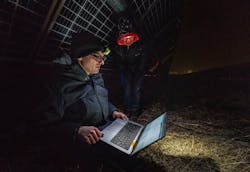Photoluminescence imaging tool inspects solar cells for invisible damage
To help address humanity’s enormous problem of climate change, we’ll need to build a lot of solar power plants. These plants can generate cheap, clean electricity—but only if they can function reliably for a long time.
So Tim Silverman, a senior scientist at the U.S. Department of Energy’s National Renewable Energy Laboratory (NREL), and colleagues are working to detect problems in existing solar cells via PLatypus, a camera system designed to detect invisible problems in fielded photovoltaic modules without making electrical connections (see video).
PLatypus images photoluminescence, which occurs when light is absorbed and re-emitted at a longer wavelength. Solar cells show photoluminescence, and the stronger the re-emitted light the better the quality of the solar cell.
“When a solar cell cracks in a hailstorm, we can’t see the crack by eye,” says Silverman. “But the crack creates two new interfaces where charge carriers tend to recombine in a way that doesn’t produce light. When we take a picture of the photoluminescence, these cracks show up darker than the surrounding areas.”
PLatypus: Create a photoluminescence image
To create a photoluminescence image, the researchers shine a monochromatic light onto a solar panel and collect the re-emitted light with a camera. It’s preferable to do this at night to avoid sunlight.
“Photoluminescence intensity is a lot dimmer than the incident light, so we needed to engineer a system that can emit a lot of light and collect the tiny amount of light that comes back with a shifted wavelength,” says Silverman.
It requires powerful LEDs, sensitive cameras, and filters to keep the original light from showing up in the image. “This is a measurement done at small scale in the laboratory for ages,” says Silverman. “But luckily, these ingredients have gotten better and cheaper, and solar cell photoluminescence intensity is getting stronger, so we can suddenly do this at large scale and low cost today.”
Most solar power plants work just fine, but the researchers designed their PLatypus tool to detect solar panel trouble if it occurs.
“I’ve always thought of photoluminescence imaging as a specialized technique for use in the lab,” says Silverman. “Then my friend Will Hobbs did it in his garage with stuff he ordered off the internet—and it was a surprise. Will and I had an a-ha! moment when we realized we could bolt together copies of the garage setup and use it in a real power plant.”
One humorous challenge the researchers faced was that midway through their first full-scale demonstration, it started snowing. Silverman and colleagues didn’t have an easy way to reschedule their demonstration, so they just cleaned the snow off the solar panels as they went. Turns out, their proof-of-concept prototype is snowproof.
“Our prototype shows that our technique works—and at reasonable cost and complexity,” says Silverman. “But it isn’t a user-friendly tool for routine use. In a future project, we’re hoping to make a new version that is. Then, instead of worrying whether their power plant has invisible damage, people can just use PLatypus to check for themselves.”
FURTHER INFORMATION/VIDEO
About the Author
Sally Cole Johnson
Editor in Chief
Sally Cole Johnson, Laser Focus World’s editor in chief, is a science and technology journalist who specializes in physics and semiconductors.


